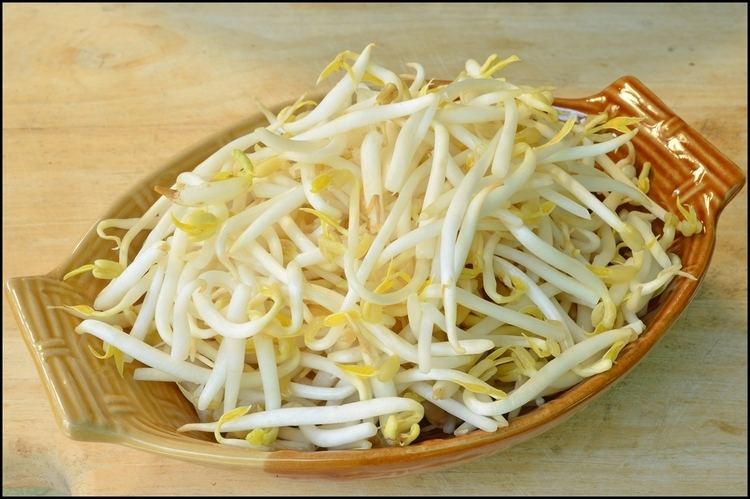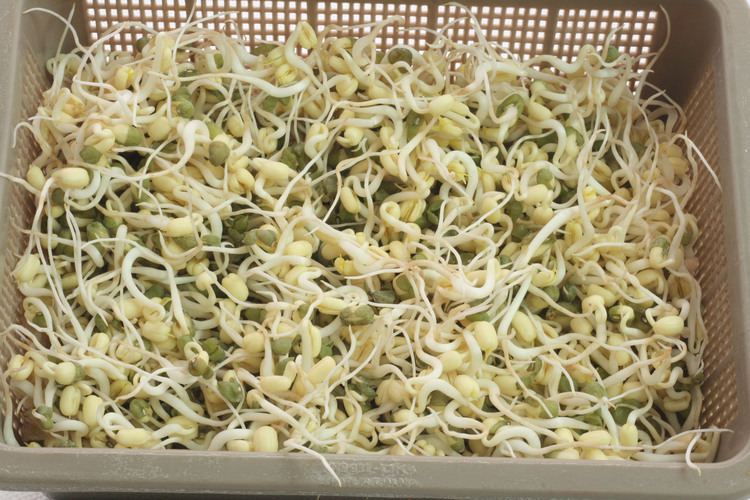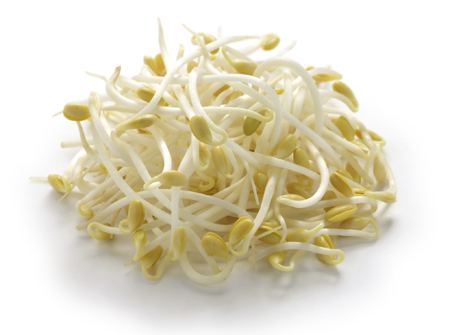Similar Brussels sprout, Cabbage, Broccoli, Carrot, Mung bean | ||
How to grow mung bean sprouts sukju namul
Bean sprouts are a common ingredient across the world. They are particularly common in Eastern Asian cuisine, made from sprouting beans.
Contents
- How to grow mung bean sprouts sukju namul
- How to grow mung bean sprouts cheap easy method
- Names
- Use
- Bacterial infection
- Antinutritional factors
- Canavanine
- EU Regulation
- Cultivation
- References

There are two types of common bean sprouts:
It typically takes one week for them to be completely grown. The sprouted beans are more nutritious than the original beans and they require much less cooking time and, therefore, less energy.

How to grow mung bean sprouts cheap easy method
Names

Use

Bean sprouts can be microwaved, or stir fried. They may also be used as an ingredient, e.g., for spring rolls before applying heat.

In Chinese cuisine, common dishes that may use bean sprouts, known as Dòu Yá ("豆芽"), are fried rice, spring rolls, egg drop soup, and hot and sour soup. They are used in Vietnamese cuisine as well.
In Korean cuisine, Soy bean sprouts 'Kongnamul' (콩나물) are more commonly used than Mung bean sprouts 'Sukjunamul' (숙주나물). And it is one of the staple ingredients for Namul and key ingredients for many Korean soups including Yukgaejang, and stir-fries such as japchae.
In Japanese cuisine moyashi (もやし) refers to, in a strict sense, the mung sprout. The soy sprouts are known as mame-moyashi (豆萌やし,糵). Bean sprouts are a common ingredient in many Japanese dishes such as stir fries and soups.
In Nepali culture, Kwati is especially prepared in a festival of "Janai Purnima" which normally falls in the month of August. Stew of Kwati is prepared by frying and mixing onion, garlic, ginger, potatoes, spices and the sprouts. Lots of variation exist from house to house but is basically about making the stew of Kwati. It is considered as a nutritious food in Nepal. The so prepared Kwati is normally eaten with rice. Sometimes meats (esp. fried goat meat) are also added to spice up the Kwati.
They are used in Thai cuisine, usually eaten in soups and stir-fried dishes. In Phad Thai they are often added in to the pan for one quick stir before serving and in soups such as Nam ngiao they are sprinkled on top of the dish.
Bacterial infection
Commercially grown sprouts have been associated with outbreaks of harmful bacteria, including salmonella and toxic forms of Escherichia coli. Such infections, which are so frequent in the United States that investigators call them "sproutbreaks", may be a result of contaminated seeds or of unhygienic production with high microbial counts. Sprout seeds can become contaminated in the fields where they are grown, and sanitizing steps may be unable to kill bacteria hidden in damaged seeds. A single surviving bacterium in a kilogram of seed can be enough to contaminate a whole batch of sprouts, according to the FDA.
To minimize the impact of the incidents and maintain public health, both the U.S. Food and Drug Administration (FDA) and Health Canada issued industry guidance on the safe manufacturing of edible sprouts and public education on their safe consumption. There are also publications for hobby farmers on safely growing and consuming sprouts at home. The recommendations include development and implementation of good agricultural practices and good manufacturing practices in the production and handling of seeds and sprouts, seed disinfection treatments, and microbial testing before the product enters the food supply.
In June 2011, contaminated bean sprouts in Germany were identified as the source of the 2011 E. coli O104:H4 outbreak. In addition to Germany, where 3,785 cases and 45 deaths had been reported by the end of the outbreak, a handful of cases were reported in several countries including Switzerland, Poland, the Netherlands, Sweden, Denmark, the UK, Canada and the USA. Virtually all affected people had been in Germany shortly before becoming ill.
Antinutritional factors
Some legumes, including sprouts, can contain toxins or antinutritional factors, which can be reduced by soaking, sprouting and cooking (e.g., stir frying). Joy Larkcom advises that to be on the safe side “one shouldn’t eat large quantities of raw legume sprouts on a regular basis, no more than about 550g (20oz) daily”.
Phytic acid, an antinutritional factor, occurs primarily in the seed coats and germ tissue of plant seeds. It forms insoluble or nearly insoluble compounds with many metal ions, including those of calcium, iron, magnesium and zinc, reducing their dietary availability. Diets high in phytic acid content and poor in these minerals produce mineral deficiency in experimental animals (Gontzea and Sutzescu, 1968, as cited in Chavan and Kadam, 1989). The latter authors state that the sprouting of cereals has been reported to decrease levels of phytic acid. Similarly, Shipard (2005) states that enzymes of germination and sprouting can help eliminate detrimental substances such as phytic acid. However, the amount of phytic acid reduction from soaking is only marginal, and not enough to counteract its antinutrient effects
Canavanine
Alfalfa seeds and sprouts contain L-canavanine. L-canavanine is potentially causing lupus-like disease in primates.
EU Regulation
In order to prevent incidents like the 2011 EHEC epidemic, the European Commission has issued three new, tightened regulations on March 11, 2013.
The origin of the seeds has to be traceable always at all stages of processing, production and distribution. Therefore, a full description of the seeds or sprouts needs to be kept on record.(see also Article 18 of Regulation (EC) No 178/2002)
This regulation amends Regulation (EC) No 2073/2005 in respect of microbiological criteria for sprouts and the sampling rules for poultry carcases and fresh poultry meat.
Imported sprouts or seeds intended for the production of sprouts need a certificate according to the model declared in the Annex of this regulation. The certificate serves as proof that the production process complies with the general hygiene provisions in Part A of Annex I to Regulation (EC) No 852/2004 and the traceability requirements of Implementing Regulation (EU) No 208/2013.
Cultivation
There are a wide variety of techniques used for sprouting. Perhaps the most common for home growers is sprouting in a jar with a fine mesh or muslin cloth tied over the top with a rubber band or string. Fresh water is then added three to four times a day and bottles are left upturned to drain. What technique to use depends on the amount that one wants to collect. The main principles are: selecting good seed (new and uniform), ensuring that light reaches the seeds and also ensuring they receive enough humidity, but avoid water content.
